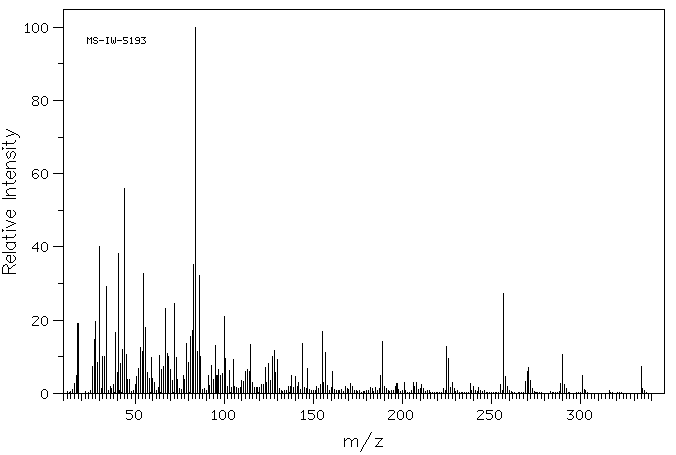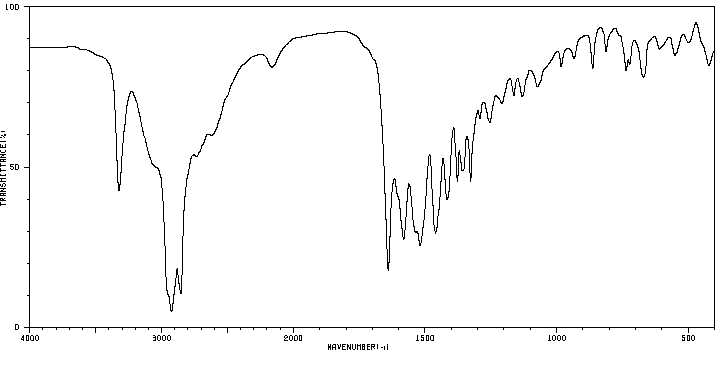N6-α-Lipoyl-L-lysin | 1676-89-7
中文名称
——
中文别名
——
英文名称
N6-α-Lipoyl-L-lysin
英文别名
N(6)-lipoyl-L-lysine;(2S)-2-amino-6-[5-(dithiolan-3-yl)pentanoylamino]hexanoic acid
CAS
1676-89-7
化学式
C14H26N2O3S2
mdl
——
分子量
334.504
InChiKey
COTIXRRJLCSLLS-KIYNQFGBSA-N
BEILSTEIN
——
EINECS
——
-
物化性质
-
计算性质
-
ADMET
-
安全信息
-
SDS
-
制备方法与用途
-
上下游信息
-
文献信息
-
表征谱图
-
同类化合物
-
相关功能分类
-
相关结构分类
计算性质
-
辛醇/水分配系数(LogP):-1.1
-
重原子数:21
-
可旋转键数:11
-
环数:1.0
-
sp3杂化的碳原子比例:0.86
-
拓扑面积:143
-
氢给体数:3
-
氢受体数:6
上下游信息
-
上游原料
中文名称 英文名称 CAS号 化学式 分子量 (±)-α-硫辛酸 (-)-Lipoic acid 1077-28-7 C8H14O2S2 206.33
反应信息
-
作为反应物:描述:N6-α-Lipoyl-L-lysin 在 sodium hydroxide 、 sodium tetrahydroborate 作用下, 生成 Nε-α-Lipoyl-L-lysin参考文献:名称:Synthesis of Some N-Lipoyl Amino Acids and Peptides摘要:DOI:10.1021/ja00863a031
-
作为产物:描述:L-赖氨酸 在 氯甲酸乙酯 、 三乙胺 、 sodium hydroxide 、 copper(II) sulfate 、 硫化氢 作用下, 以 乙腈 、 水 、 溶剂黄146 为溶剂, 生成 N6-α-Lipoyl-L-lysin参考文献:名称:EP1547590摘要:公开号:
文献信息
-
Site-specific protein modification by genetic encoded disulfide compatible thiols作者:Xinyu Ling、Heqi Chen、Wei Zheng、Liying Chang、Yong Wang、Tao LiuDOI:10.1016/j.cclet.2019.04.075日期:2020.1convenient way for site-specific protein modification. However, recombinant expression of disulfide bonding containing protein with unpaired cysteine is technically challenging and the resulting protein often suffers from significantly reduced yield and activity. Here we used genetic code expansion technique to introduce a surface exposed self-paired di-thiol functional group into proteins, which can be
-
Reed et al., Journal of Biological Chemistry, 1958, vol. 232, p. 143,144作者:Reed et al.DOI:——日期:——
-
Nawa et al., Journal of the American Chemical Society, 1959, vol. 81, p. 2908,2909作者:Nawa et al.DOI:——日期:——
-
Role of Lipoylation of the Immunodominant Epitope of Pyruvate Dehydrogenase Complex: Toward a Peptide-Based Diagnostic Assay for Primary Biliary Cirrhosis作者:Giulia Pacini、Alfonso Carotenuto、Cedric Rentier、Francesca Nuti、Feliciana Real-Fernandez、Diego Brancaccio、Giuseppina Sabatino、Maud Larregola、Elisa Peroni、Paola Migliorini、Ettore Novellino、Pier Maria Battezzati、Carlo Selmi、Anna Maria Papini、Paolo RoveroDOI:10.1021/acs.jmedchem.5b00783日期:2015.8.27Primary biliary cirrhosis is an immune-mediated chronic liver disease whose diagnosis relies on the detection of serum antimitochondrial antibodies directed against a complex set of proteins, among which pyruvate dehydrogenase complex is considered the main autoantigen. We studied the immunological role of the lipoyl domain of this protein using synthetic lipoylated peptides, showing that the lipoyl chain chirality does not affect autoantibody recognition and, most importantly, confirming that both lipoylated and unlipoylated peptides are able to recognize specific autoantibodies in patients sera. In fact, 74% of patients sera recognize at least one of the tested peptides but very few positive sera recognized exclusively the lipoylated peptide, suggesting that the lipoamide moiety plays a marginal role within the autoreactive epitope. These results are supported by a conformational analysis showing that the lipoyl moiety of pyruvate dehydrogenase complex appears to be involved in hydrophobic interactions, which may limit its exposition and thus its contribution to the complex antigenic epitope. A preliminary analysis of the specificity of the two most active peptides indicates that they could be part of a panel of synthetic antigens collectively able to mimic in a simple immunoenzymatic assay the complex positivity pattern detected in immunofluorescence.
表征谱图
-
氢谱1HNMR
-
质谱MS
-
碳谱13CNMR
-
红外IR
-
拉曼Raman
-
峰位数据
-
峰位匹配
-
表征信息
同类化合物
螺[二环[2.2.1]庚烷-2,2'-[1,3]二噁戊环]-5-乙醇,(1S,4R,5R)-
芦笋酸
硫辛酸钠
硫辛酸氨基丁三醇盐
硫辛酸杂质D
硫辛酸杂质9
硫辛酸乙酯
硫辛酸-二聚乙二醇-马来酰亚胺
硫辛酰氨基-PEG12-羧酸
甲基沙蚕毒素
沙蚕毒素
氨基乙醛乙烷二硫代缩醛
左旋硫辛酸
呋喃-2-甲醛乙烷-1,2-二基二硫代缩醛
二乙基硫辛酰胺
三硫代碳酸乙烯酯
rac-α-硫辛酸-d5
R-(alpha)-硫辛酸氨基丁三醇盐
R-(+)-硫辛酸
N-(1,3-二噻戊环-2-亚基氨基)乙酰胺
N-(1,3-二噻戊环-2-亚基氨基)-2-氧代丙酰胺
L-赖氨酸单-1,2-二噻戊环-3-戊酸盐
DL-α-硫辛酸-NHS
5-[(3R)-二噻戊环-3-基]戊酸;2-羟基丙酸
4-甲基二噻戊环-3-酮
4-甲基-1,3-二硫醇-2-酮
4-甲基-1,3-二噻戊环-2-亚胺盐酸盐
4-甲基-1,2-噻吩-4-羧酸
4-甲基-1,2-二噻吩-4-羧胺
4-噻唑烷酮,3-(二甲氨基)-2-亚硫酰基-,(Z)-
4-乙基-1,3-二噻戊环-2-硫酮
4-[[5-(1,2-二噻戊环-3-基)-1-氧代戊基]氨基]丁酸
4-[(苯基硫基)甲基]苯甲酸
4,5-二甲基-2-[2-(甲硫基)乙基]-1,3-二噻戊环
3-环丁烯砜-D6
2-甲基-1,3-二硫戊环
2-异丙基-4-甲基-1,3-二噻戊环
2-己基-1,3-二噻戊环
2-亚甲基-1,3-二硫杂环戊烷
2-(氯甲基)-1,3-二噻戊环
2-(三氯甲基)-1,3-二噻戊环
2-(2-噻吩基)-1,3-二噻戊环
2-(2,4-环戊二烯-1-亚基)-1,3-二硫戊环
2-(1,3-二噻戊环-2-基)-1,3-二噻戊环
2-(1,2-二硫烷-3-基)乙酸
2,4-二氯-6,7-二硫杂双环[3.2.1]辛烷
2,3-二硫杂螺[4.4]壬烷
2,3,7,8-四硫杂螺[4.4]壬烷
2,2'-[1,2-乙烷二基二(硫代)]二[2-(三氟甲基)-1,3-二噻戊环]
1,‐2-二硫戊基-4-醇








